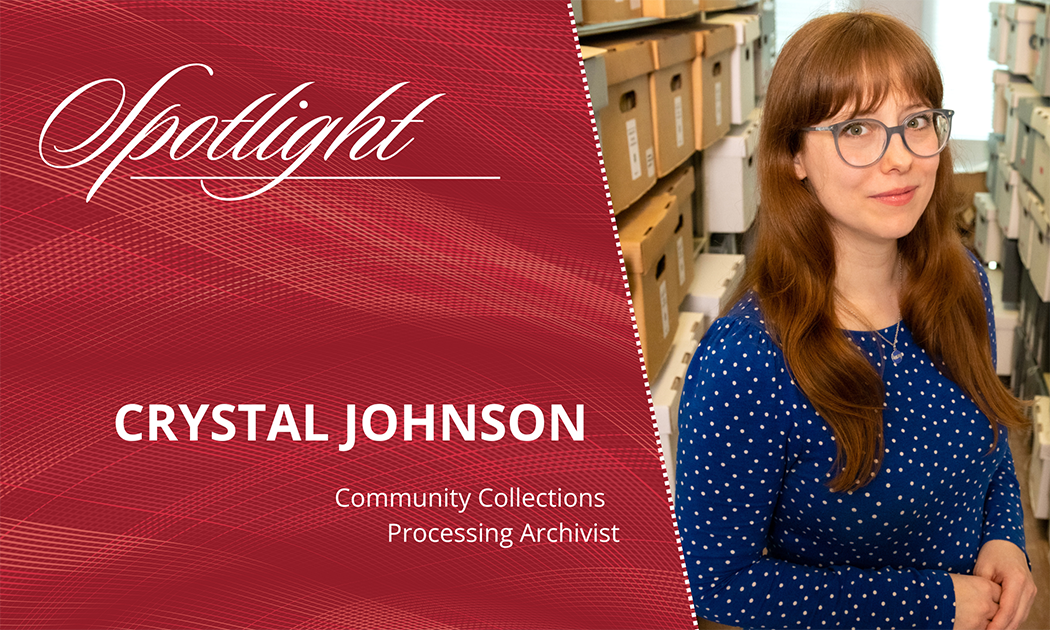
At the University Libraries, faculty and staff bring diverse backgrounds and interests to their roles, elevating the Libraries’ culture of interdisciplinary collaboration and lifelong learning and curiosity. We asked Community Collections Processing Archivist Crystal Johnson a few questions about her work, to find out more about the inspiration behind her contributions to the campus community.
Q: In your own words, what is a quick overview of your role at the Libraries?
A: My role is to increase representation in our collections with an emphasis on identifying and filling gaps. I do this by making materials from our backlog accessible and bringing in new collections. I also raise awareness of the University Archives, our collections, and services by leading our outreach programs.
Q: Talk a little about the work you’re most passionate about. Why have you chosen to pursue this work within a library setting?
A: People can be intimidated by the idea of an archive, thinking we only value the voices of individuals who have won Nobel Prizes. But really, we value the everyday efforts that keep our university running. Everyone in our community, whether they are staff, faculty, current students, or alumni is part of the collective history of CMU, and their voice matters. My favorite part of my job is connecting with community members, listening to their stories, and learning how their CMU experience has impacted them.
Q: Share an experience or skillset that people might not expect an archivist to have. How is it a game changer for the work you do at CMU?
A: Being good at solving puzzles. A big part of my job is “processing” collections, which is an archives term for taking in, organizing, inventorying, and describing groups of records so they’re accessible and understandable to researchers. We often receive dozens of boxes spanning decades of someone’s career — with no clear order. It’s up to us to figure out the structure: identifying themes, formats, dates, and solving mysteries like “Why is this here?” or “Where does this fit?” It’s essentially a giant puzzle. The goal is to make the collection easy for anyone, whether they’re a serious scholar or a curious student, to access and use while still respecting how the materials were created and originally used.
Think of your Google Drive or a stack of papers around your house: how easy would it be for a complete stranger to figure out who you are, what you’ve done, and find exactly what they’re looking for? That’s the challenge and the fun of being an archivist.
Q: The Libraries serves as a neutral convening space to bring different areas of campus together. How do you value collaboration in your work? Can you give us an example of a recent collaboration that has helped a project reach new heights?
A: One of the most rewarding collaborations this past year was co-leading the Libraries Student Advisory Council. Alongside two colleagues from the Libraries, we partnered with student council members to increase awareness and understanding of the Archives and our mission.
Students identified campus organizations they believed should be represented in the Archives, then took the lead in reaching out and building those connections. The year-long effort culminated in a collaboratively planned event showcasing archival materials and new items collected from student organizations.
The council brought together a dynamic mix of students, undergraduates, and graduates from various majors and class years, whose diverse perspectives added depth and richness to every conversation.
Working closely with students and colleagues outside the Archives gave me invaluable perspective: how students view (or don’t view) the Archives, how they preserve their histories, and how we can better support and represent them in our collections. It was a great example of how collaboration can amplify impact and bring fresh energy and insight into our work.
Q: What’s an area that you want to innovate and push boundaries in? Why is it exciting to you?
A: I’m interested in finding new ways to highlight stories that haven’t always been included in the Archives. I want to encourage people to think about their own experiences — what they’ve built, contributed to, or been part of — and how those things can be documented and preserved. What excites me is the chance to make the Archives feel connected to everyday life, not just history. It’s about showing people that their stories are important and belong here, too.
Q: What’s something in the Libraries that speaks to you personally? This can be a book, something in the Archives or Special Collections, a space in one of the buildings — anything you want to highlight!
A: My favorite place is the Archives’ Reading Room. My fellow archivists have worked hard to make it feel like a true community space. Many reading rooms are quiet, formal places, but ours is lively and full of great conversations with researchers, students, and visitors. It’s a welcoming space where there’s always something interesting to discover (robots, vintage CMU merch, print specimens, even a marionette!). We also host events there, and I’ll plug our drop-in hours: every Thursday from 10 a.m. to 4 p.m. No appointment is needed, and we welcome all levels of curiosity.
